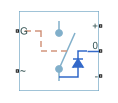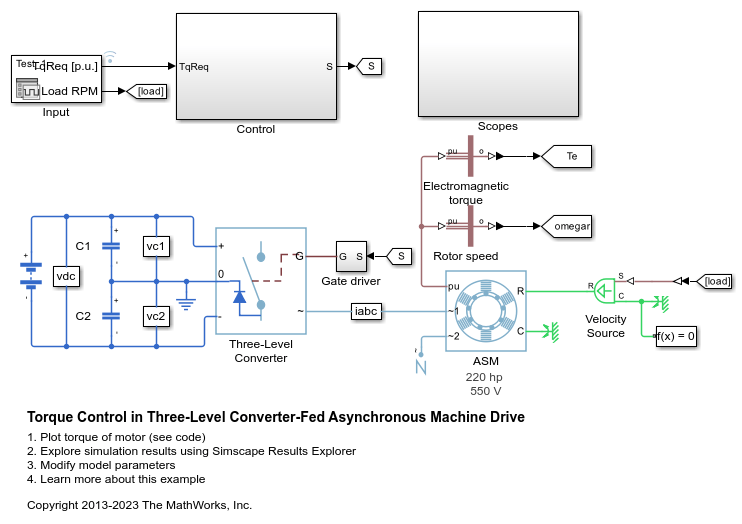Three-Level Converter (Three-Phase)
Twelve-pulse three-phase three-level neutral-point clamped controlled converter
Libraries:
Simscape /
Electrical /
Semiconductors & Converters /
Converters
Description
The Three-Level Converter (Three-Phase) block models a twelve-pulse three-phase three-level neutral-point clamped controlled converter. You can use this block to connect a three-phase AC network to a three-level DC network.
Model
The block contains three bridge arms, each of which has four switching devices and the associated anti-parallel diodes. Options for the type of switching devices are:
GTO — Gate turn-off thyristor. For information about the I-V characteristic of the device, see GTO.
Ideal semiconductor switch — For information about the I-V characteristic of the device, see Ideal Semiconductor Switch.
IGBT — Insulated-gate bipolar transistor. For information about the I-V characteristic of the device, see IGBT (Ideal, Switching).
MOSFET — N-channel metal-oxide-semiconductor field-effect transistor. For information about the I-V characteristic of the device, see MOSFET (Ideal, Switching).
Averaged Switch — Semiconductor switch with an anti-parallel diode. The control signal port, G, accepts values in the
[0,1]interval. When the value at port G is equal to0or1, the averaged switch is either fully opened or fully closed, and it behaves similarly to the Ideal Semiconductor Switch block with an anti-parallel diode. When the value at port G is between0and1, the averaged switch is partly opened. You can then average the PWM signal over a specified period. This allows for undersampling of the model or using modulation waveforms instead of PWM signals.
Each component in the three-arm circuit is the same switching device that you specify. The switching devices are the same as the devices in the Semiconductors > Fundamental Components sublibrary.
The figure shows the equivalent circuit for the block using an Ideal Semiconductor block as the switching device.

You control the gate ports of the 12 switching devices via an input to the Three-Level Converter (Three-Phase) block G port.
Use a Twelve-Pulse Gate Multiplexer block to multiplex all 12 gate signals into a single vector.
Connect the output of the Twelve-Pulse Gate Multiplexer block to the Three-Level Converter (Three-Phase) block G port.
You use the Diodes tab of the block dialog box to include an integral protection diode for each switching device. An integral diode protects the semiconductor device by providing a conduction path for reverse current. An inductive load can produce a high reverse-voltage spike when the semiconductor device suddenly switches off the voltage supply to the load.
The table shows how to set the Integral protection diode parameter based on your goals.
| Goals | Value to Select | Integral Protection Diode |
|---|---|---|
| Prioritize simulation speed. | Diode with no dynamics | The Diode block |
| Prioritize model fidelity by precisely specifying reverse-mode charge dynamics. | Diode with charge dynamics | The dynamic model of the Diode block |
You use the Snubbers tab of the block dialog box to include a snubber circuit for each switching device. Each snubber consists of a resistor and capacitor connected in series. Typically, a snubber circuit protects a switching device against very high voltages produced by an inductive load when the device turns off the voltage supply to the load. Snubber circuits also prevent excessive rates of change of current when a switching device turns on.
Piecewise Constant Approximation in Averaged Switch for FPGA Deployment
If you set the Switching device parameter to Averaged switch and your model uses a partitioning solver, this block produces nonlinear partitions because the average mode equations include modes, Gsat that are functions of the input G. To make these equations compatible with hardware description language (HDL) code generation, and therefore FPGA deployment, set the Integer for piecewise constant approximation of gate input (0 for disabled) parameter to a value greater than 0. This block then treats the Gsat mode as a piecewise constant integer with a fixed range. This turns the previously nonlinear partitions to linear time varying partitions.
An integer value in the range [0,K], where K is the value of the Integer for piecewise constant approximation of gate input (0 for disabled), is now associated with each real value mode in the range [0,1]. The block computes the piecewise constant mode by dividing the original mode by K to normalize it back to the range [0,1]:


